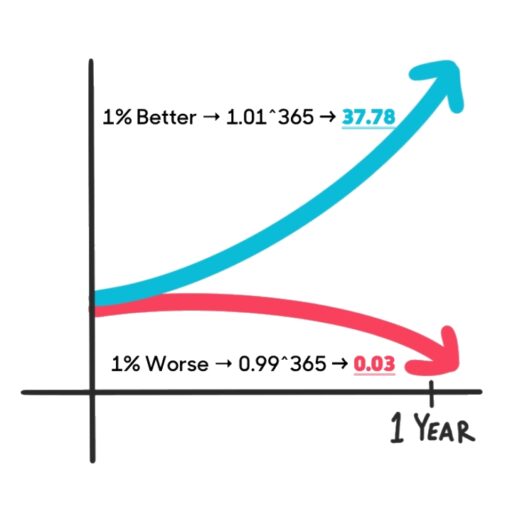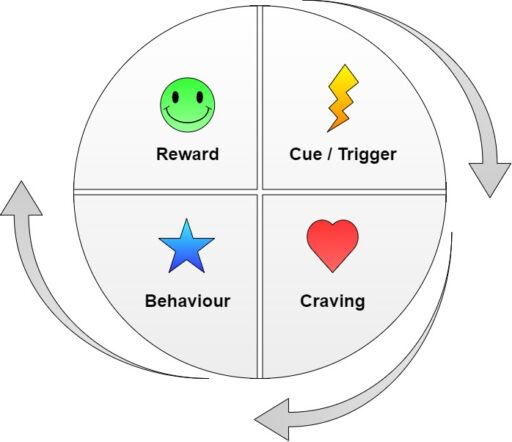Building Effective Habits
 With habits you become 1% better each day.
With habits you become 1% better each day.
It's a fact that the result of a habit is not felt, seen, or noticed in a single day.
But a consistent habit that becomes a part of your identity can make a big difference over a life-time. Because when you are 1% better on a daily basis, your results will compound over time and this ultimately shapes the future you attain:
“People do not decide their futures, they decide their habits and their habits decide their futures.”
- F.M. Alexander
Habits are Easy-To-Use Daily Systems
“Goals are about the results you want to achieve. Systems are about the processes that lead to those results."
- James Clear
In other words, habits are the behaviour we fall back on as a standard operating procedure. So, having the right habits in place will allow you to stay on track when life becomes busy.
The question then is how do we learn and internalize habits so they become a part of us?
Cultivating Identity Habits
Habits are learned when we do something often enough and get rewarded for it. But habits are not magic. Everyone will miss an activity once in a while. So the underlying goal of a habit is to make sure you don't miss twice:
“You do not rise to the level of your goals. You fall to the level of your systems.”
- James Clear
Instead of creating habits based on results, habits should therefore be created around your identity This way, they will become a part of who you are.
"With outcome-based habits, the focus is on what you want to achieve. With identity-based habits, the focus is on who you wish to become."
- James Clear
Nevertheless, habits and relating them to our identity can a double edged sword. Because in some cases, your identity is what actually holds you back:
I'm a sweet tooth
I am so bad at remembering
I know I'm terrible with sports
That's why it is so important to cultivate positive identity habits:
I'm always on time
I read every day
I am someone that finishes what they start
Never do I miss a workout
Put differently, when we employ habits that are related to our identity, we are stacking up small wins until it becomes our standard of excellence:
We are what we repeatedly do. Excellence, then, is not an act, but a habit.
- Aristotle
Creating Effective Habits

Effective Habits follow the Habit Loop.
They work, most of the time, due to the basic mechanism of our brain to react to a stimulus.
This applies to good and bad habits.
So for good habits, we want to strengthen the loop.
For bad habits we want to weaken the loop.
This means that for new positive habits the most important thing is to make them them easy to follow (by making it visual) and by making it worthy to do (by including a reward).
Here is an overview of the 4 stages and how good and bad habits should be designed or broken.
Stage 1. The Cue
The first step in the habit is a cue. This is what triggers the brain to execute the habit. Stated differently, it is the antecedent, a trigger that engages you to express either the right or the wrong behaviour.
It is a good idea to take some time and understand how your environment is creating triggers that lead to a certain behaviour. To truly build positive habits, the cue should be clearly identified if you wish to build the right response.
There are three main ways to do this:
- Create an implementation intention
- Make a visual cue
- Think of a motivation ritual
Use the implementation intention
An implementation intention looks like this:
I will do [behaviour X] at [place] [time]
Vague habits do not work, specific ones do.
So use the implementation intention to transform vague habits into specific habits:
“I’m going to exercise more”
To:
“I will exercise every Tuesday, Thursday and Saturday at 9 am for 50 minutes and will do three sets for my main lifts and 4 sets for assistance exercises."
Create visual cues
Visual cues are strong reminders and motivators because of their visibility so they are not ignored easily. For example, use a calendar with daily check marks to create a habit cycle. In this case, your only job is to not break the chain! If that happens anyway, the goal is to make sure you are back on track the next day. In other words, missing once can happen, missing twice is neglect from your side.
Last but not least, make habits visual by using a sandglass. This cue works excellent because as soon as the sandglass is turned the time will start running to work on your new habit. In this instance you will see time 'flow' and the time may only be spent on the habit you are trying to cultivate (reading, exercising, learning, cleaning etc).

Use a motivation ritual
A motivation ritual can be used to prime yourself for the habit you are trying to cultivate. This can be a simple act like listening to powerful music, to drive up your emotional state.
Besides playing music it can also be a physiological ritual that invokes your body language to provoke a specific reaction. For example, try standing up straight and holding a power pose. Using your body language to create a mental feeling so that you will act on it.
Stage 2. The Craving
The craving is the force of motivation for your behaviour. It is an internal reaction that is created because of the external stimulus. The craving is not the habit itself, but it does create a change in your state that needs to be fulfilled. To build good habits, the craving should be attractive. Temptation bundling is one way of making a habit attractive.
Use temptation bundling
Temptation bundling is combining two activities - one you enjoy and one you do not enjoy.
Bundling can either be done at the same time (listening to music while jogging/exercising) or by putting the activity you enjoy right after the activity that you do not enjoy (in which case the craving is the created because of the anticipation of a reward, which is called delayed momentary gratification).
Stage 3. The Response
The response is the behaviour of the habit. It can be a thought or an action, to which a reward is delivered. This is the actual behaviour you are trying to cultivate. Here, positive habits should be made easy instead of difficult.
Here are two main ways to create easy habits:
Use the hop step jump method to start small
Start small to create initial momentum for your habit. This can be as simple as a 2 minute rule to do the habit, or a small step that invites you to perform the habit, and taking small steps along the way to invoke the right response.
I will put on my shoes > go outside to walk > then might as well jog one block.
Let's go to the gym for 2 exercises > I do my two exercises and start breaking a sweat > I might as well do a little bit more because it feels good.
Now is a good time to read for 5 minutes > if I have interest I will keep reading, if not I will stop > repeat.
The fact is that anything you start is better than everything you only plan. Therefore, the decent method that you follow is better than the perfect method that you quit. So, start small, and create action instead of motion. Create that confidence in yourself by using the power of repetition with positive action.
In other words, the best way to build trust in yourself is by doing the action and by reducing the friction. By reducing friction and making change easy we follow the pareto principle, which states that only 20% of the effort can already give you 80% of the results - if you follow it consistently.
Stage 4. The Reward
The fourth law of creating smart habits is making it satisfying vs. unsatisfying. Here, the reward actually ensures that positive behaviour will be repeated. For example, by having a positive reward as a consequence of the habit you strengthen the behaviour. As a result, a virtuous cycle is constructed.
What's interesting is that the anticipation of a reward is really what prompts us to act, and not necessarily the reward itself:
“It is the anticipation of a reward—not the fulfillment of it—that gets us to take action. The greater the anticipation, the greater the dopamine spike.”
- James Clear
The same principle applies to the anticipation of a punishment, which motivates us to act if that means that we can avoid the punishment itself.
For example, if you have an accountability partner that knows about your new habit, give this person 100 euros. Then tell them to give back 10 euros each time you perform the habit. Moreover, this type of reward works, because you the reward is that you are avoiding punishment.
Making habits permanent

References
Clear, J. (2019). Atomic Habits



Comments are closed.